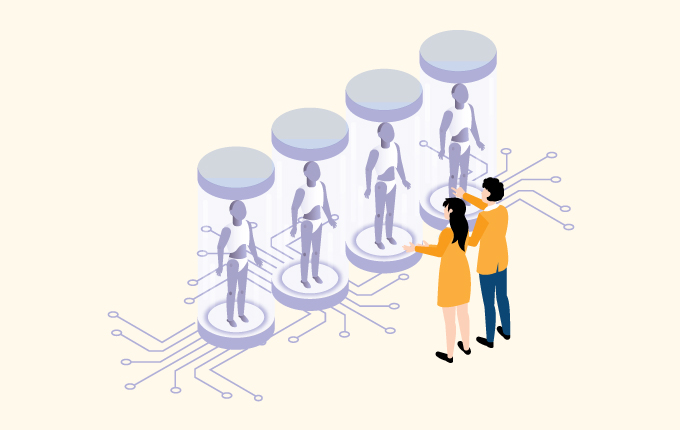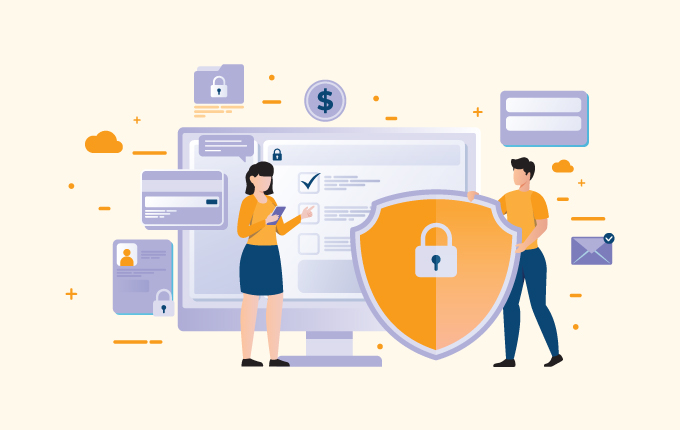Business IntelligenceIT Consulting & StrategySecuritySoftware DevelopmentTech Support & Managed IT ServicesConstructionEducationFinanceHealthcareLegalNon-ProfitsReal EstateStartups
We’ve been talking a lot about the future of work and hybrid offices specifically lately. It’s an important topic, especially as more and more businesses embrace this approach.

One of the bigger challenges around hybrid work is security. The hybrid office, which allows for employees to either be remote or in-house (or a mix of the two), opens up your business to threats in a way that we haven’t really experienced before.
What are the challenges of hybrid office security?
Unlike the traditional office, hybrid workspaces make it possible for your employees to work from pretty much anywhere. This means that they’re not always working from your secure internal network. They could be using their home internet, working from a café or coworking space, or even from an airport or train. This creates a situation where your security teams need to monitor both secure and unsecured network traffic, which can be incredibly challenging (unless you do something about this).
On top of this, employees are ever-so-slightly more distracted when they’re not in the office. At the beginning of the COVID-19 pandemic, this led to an increase in cyberattacks, mostly because people had to suddenly juggle not just work, but also schooling for their kids, the pandemic itself, and everything that came with it.
The final challenge we’ll mention is that, unless you have a strong policy on the kinds of devices your employees use, your staff could be using personal devices for work. Even if this only happens once in a while, this leaves you wide open to cyberattacks and data breaches.
These aren’t the only security issues that come with the hybrid office, but they’re among the most common we see.
What kinds of threats exist for hybrid offices?
The types of threats that exist for a hybrid workspace aren’t that much different from a traditional office, but solving the problems is trickier. Before you solve the problems, though, it helps to be aware of the potential issues that your business faces.
Human error
Human error is a big part of the challenge of hybrid security. This comes in the form of devices being lost or stolen while in public or even people leaving physical documents behind when they leave a cafe or coworking space.
As we said, some of this is because it’s easy to be distracted while working remotely. Sometimes you’re trying to manage home life and work at the same time or you’re working in a busy, loud space. In situations like that, your attention is divided and that’s all it takes sometimes to either leave something behind or click the wrong link in an email.
It can even be something as simple as talking about work-related topics in a public place and having someone listen in.
Security training is the best approach to managing this problem. Providing your team with regular sessions that both remind staff of existing security issues and cover new ones can help keep protecting business data, IP, and property top of mind. The more frequently you do this, the more likely it is that your team is going to remember small details, like not leaving a laptop unattended when they use the bathroom in a café, for example.
When it comes to lost devices, mobile device management (MDM) can help here. With MDM, network administrators are ultimately able to look after any device that accesses the network. That means if you’re using a laptop, for example, and it gets lost, IT can go in there and remotely wipe everything from the computer. This helps keep company data out of the hands of anyone who doesn’t work for the company.
Exposed networks
People working from home, coworking places, or cafes probably don’t have the same basic security in place that you have at your business. This means that they’re naturally more exposed to potential cyberthreats and, by extension, so is your business.
At the bare minimum, remote employees need to have a VPN to ensure that everyone has a secure pipeline to your network. VPNs help protect remote workers as they sign in, access data, and do their work. A good way to take this one step further is with strong access controls and multi-factor authentication. Access control makes it possible for employees to access what they need to do their jobs within your business and nothing else. That means that no one, not even the CEO, can access everything in the network. What this does is keeps cybercriminals effectively locked in a small room if they’re able to break into your network. Multi-factor authentication requires employees to verify their identities beyond a password, using a second device.
Spread out employees
Having employees working from a variety of locations and using a multitude of different devices creates a lot of work for tech staff. It’s not impossible, but without a strong security setup, clear guidelines as to what is and isn’t acceptable, and monitoring, there are going to be holes in your system.
That’s why it’s important to implement things like what we’ve mentioned above (MDM, access control, VPNs). But you should also be looking to implement endpoint security, which ensures that everything that connects to your network is being proactively watched, often by AI-based security platforms. AI helps here because it separates out the noise. If your employees are doing something that looks suspicious to the monitoring platform, but isn’t, the AI can learn to ignore that signal. The more time spent monitoring, the more the AI learns what normal usage is for your employees and can filter it out to focus more on the abnormalities (like a sudden surge in login attempts).
It’s time to secure your hybrid workforce
Are you moving towards a more modern way of working and looking to increase security? If that’s the direction your business is heading, let’s talk. We can help you create the ideal security setup for your hybrid approach to work that ensures you’re paying attention to what’s going on. And, we can help your staff (both remote and in-office) understand what threats look like and teach them how they can help create a culture of safety.
Contact us today to learn more.



 July 13, 2022
July 13, 2022 Homefield IT
Homefield IT

